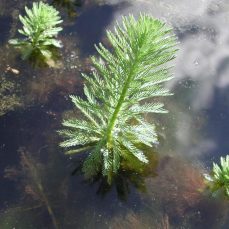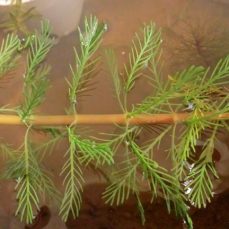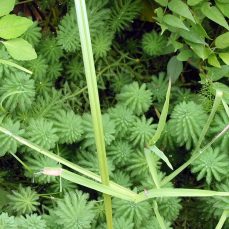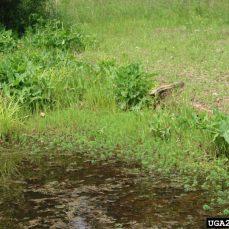Parrotfeather (Myriophyllum aquaticum)

Photo credit: Graves Lovell, Alabama Department of Conservation and Natural Resources, Bugwood.org

Management Strategy
Squamish
Whistler
Pemberton
Vectors of Spread
Synonyms
- Parrotweed
- Water feather
- Parrot’s feather
- Brazilian watermilfoil
ID Characteristics
General: Parrotfeather is an aquatic plant in the watermilfoil family (Haloragaceae).
Flowers: Inconspicuous (1.6 mm) white flowers that emerge from the axils of shoots.
Stems: The submersed stems are reddish and creep along the water surface, while the green emergent stems grow vertically up to 30 cm above the water. Stems can grow 2 – 5 m long, with extensive branching throughout.
Leaves: The feather-like leaves are heterophyllous, meaning they exist both above and below water. Emergent leaves grow in whorls of 4 – 6 per node and appear bright green, waxy and stiff. Submerged leaves occur in whorls of 3 – 6 and are tinged red.
Roots: Thin hair-like roots arise from the nodes of stems. The roots establish themselves in the bottom sediments of water bodies.
Fruits: Parrotfeather does not produce seeds outside its native range.
Similar Species
Exotic:
- Cutleaf watermilfoil (Myriophyllum pinnatum) has darker stems and foliage than parrotfeather. It is native to Eastern North America.

Cutleaf watermilfoil (photo credit: moondevg, iNaturalist)
Invasive:
- Eurasian watermilfoil (Myriophyllum spicatum) also resembles parrotfeather, but it is reddish-brown and has more pairs of leaflets per leaf (14 – 21).
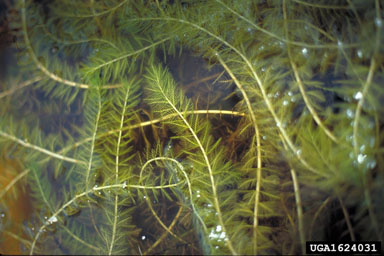
Eurasian Watermilfoil (Photo credit: Alison Fox, University of Florida, Bugwood.org)
Habitat and Origin
Parrotfeather is native to South America and arrived in North America as an ornamental pond plant in the early 1900s.
Parrotfeather prefers nutrient-rich, freshwater, slow-moving water bodies such as tributaries, ponds, lakes and canals. This plant thrives in ample light, alkaline and high-nutrient environments.
Parrotfeather can only withstand mild winters, so while temperatures in the Sea to Sky Corridor typically dip below tolerable conditions for the plant to survive year-round, it’s likely that climate change will be broadening its range.
How it Spreads
Parrotfeather reproduces vegetatively through plant fragments. Plant fragments as small as 4 mm are capable of establishing a new population. As male plants are not present outside their native range, female plants cannot produce seeds.
While parrotfeather does spread vegetatively, humans are a primary means of dispersal. Parrotfeather is commonly purchased for aquariums and aquatic gardens and can travel long distances by hitching a ride on boats, boat trailers, and other gear.
Impacts
Ecological:
- Can form dense mats that outcompete native aquatic plants, especially in shallow ponds.
- Impedes water flow and traps sediment.
- Creates suitable habitat for mosquito larvae.
- Infestations reduce levels of dissolved oxygen in the water, which can change invertebrate communities and contribute in an increase of non-native fish species populations.
Economic:
- Dense infestations can impede the movement of boats, damage equipment, and clog drainage ditches.
Stop the Spread
Parrotfeather is not yet found in the Sea to Sky region, but is found in neighbouring areas and may arrive here soon. The goal is to prevent parrotweed’s introduction by focusing on education and awareness. If prevention fails, the goal will become immediate eradication following the proposed SSISC EDRR protocol.
Learn to identify parrotfeather: use the images presented in this profile page to learn how to identify parrotweed.
What to do if you spot it: You can report any parrotfeather sighting by visiting our reporting page.
DO:
- Clean, Drain, and Dry all watercraft. Rinse all mud, debris, and plant fragments from all equipment, wading gear, and boats.
- Ensure all plant parts are bagged and covered during transport to a designated disposal site.
DO NOT:
- Plant parrotfeather in an aquarium or a water garden, no matter how well-contained its enclosure may seem.
- Dispose of aquarium plants into water bodies.
- DO NOT compost.
Control
Cultural
Growth of parrotfeather can be controlled by placing a permeable shade cloth or other synthetic barrier to block light and smother the infestation.
Mechanical
Attempting to control parrotfeather mechanically tends to spread the plant and should only be conducted with extreme caution, ideally in small, contained water bodies. For larger water bodies, we advise the use of a cloth screen or floating net to contain the treatment area. Raking and hand-pulling may offer temporary control; however, this approach is very labour intensive, as dense mats are heavy and can damage equipment. Moreover, note that this treatment may impact other species. Alternatively, re-planting riparian areas with non-invasive species can create shade and reduce parrotfeather’s growth. For best results, combine several mechanical control methods and monitor treated sites often.
Chemical
Chemical control is impossible due to the aquatic nature of this plant.
Biological
There is no biocontrol available for this plant.
Parrotfeather Distribution in BC
Parrotfeather Factsheet
Having trouble viewing the factsheet? Don’t worry, all the information is included on this page. You can also contact us with any questions.
Additional Resources
References
- BioNET-EAFRINET, Myriophyllum aquaticum (Parrot’s feather) Factsheet
- California Invasive Plant Council, Myriophyllum aquaticum
- Centre for Invasive Species and Ecsystem Health, Parrot-Feather
- Electronic Atlas of the Flora of BC, Myriophyllum aquaticum
- Electronic Atlas of the Flora of BC, Myriophyllum pinnatum
- Electronic Atlas of the Flora of BC, Myriphyllum spicatum
- Great Lakes Aquatic Nonindigenous Species Information System, Myriophyllum aquaticum (Vell.) Verdc.
- Invasive Plant Atlas of the United States, Parrotfeather
- United States Geological Survey, Myriophyllum aquaticum (Vell.) Verdc.




